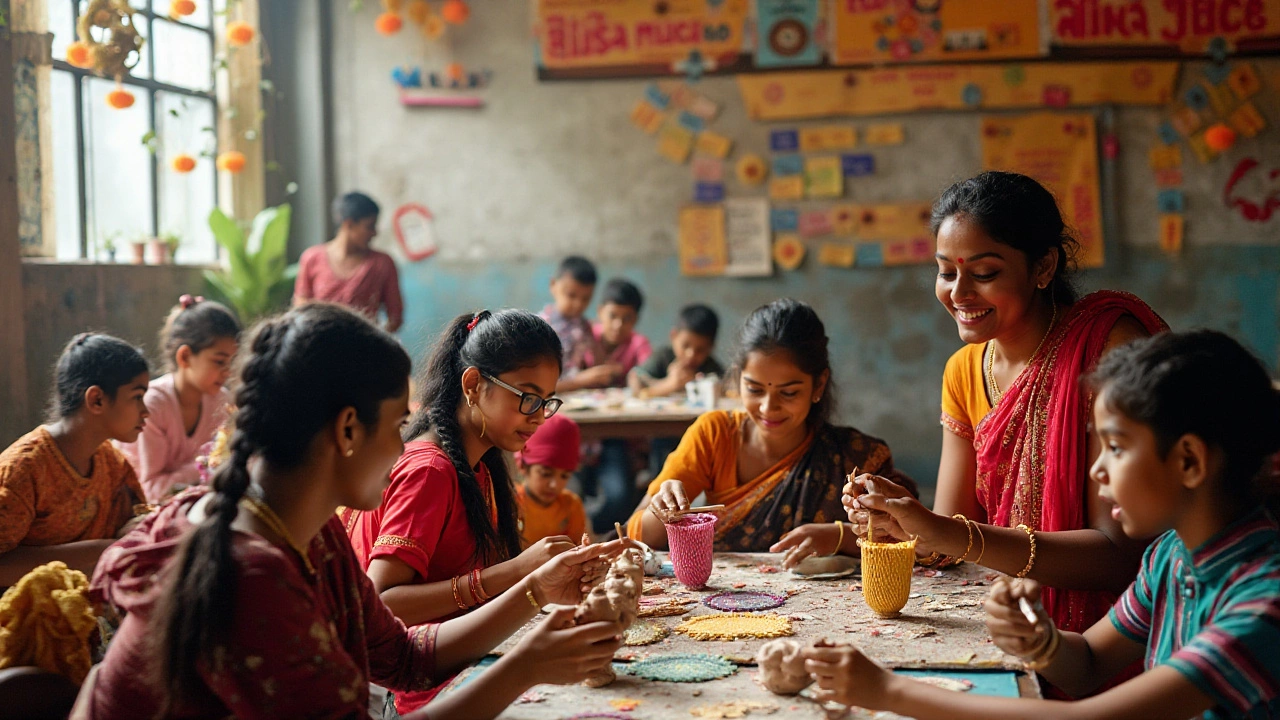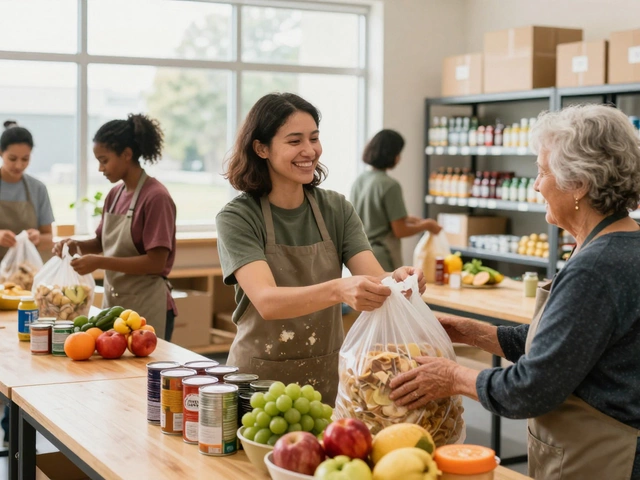Volunteering has long been synonymous with charity work and community service, but for those seeking something a little different or off the beaten path, there are myriad opportunities to explore. When looking beyond traditional volunteering, we find that contributing to society can take many creative and impactful forms.
In today's fast-paced world, finding the right fit for your unique skills and interests can make all the difference in how you engage with your community. Whether it's through skill-based contributions, creative engagements, or harnessing the power of digital platforms, there's a niche for every passion.
Here, we'll unravel various ways to immerse yourself in meaningful work without having to stick to conventional methods. It's about discovering what resonates with you and aligning your efforts to make the world just a little brighter.
- Understanding Volunteering Beyond the Traditional Sense
- Skill-Based Contributions
- Creative Engagements
- Becoming a Catalyst for Change
- Digital Platforms and Virtual Involvement
- Small Acts with Big Impacts
Understanding Volunteering Beyond the Traditional Sense
When we think of volunteering, images of soup kitchens and community clean-ups often come to mind. But this conventional view doesn't capture the full spectrum of ways individuals can contribute to society. Volunteering transcends these traditional activities and can be seen as a broad concept where personal talents, skills, and passions are mobilized to make a positive impact. The 21st century has been characterized by a profound change in how people view their contributions to society, combined with technological advancements and an emphasis on individual strengths.
Notably, volunteering can be personalized to fit into one's lifestyle and skill set. For instance, professionals in the fields of graphic design, marketing, or finance can offer pro bono services to non-profit organizations, thus enabling both personal and organizational growth. This evolution allows for a tailored approach where skills that might not have had an obvious outlet in traditional volunteering can be put to good use. According to a study by the Corporation for National and Community Service, people utilizing their professional talents in informal volunteering roles feel more enriched and engaged compared to those in more generic tasks.
Moreover, volunteering is no longer confined to local efforts. Virtual volunteering platforms enable individuals to contribute to causes across the globe without leaving the comfort of their homes. Organizations like Crisis Text Line and Translators without Borders allow people to directly affect lives from afar. This method not only minimizes geographical barriers but also makes volunteering accessible for those with physical limitations or tight schedules. Such flexibility widens the scope and scale of social impact, empowering individuals to create change irrespective of their physical location.
"Volunteering allows individuals to give back in ways they are most passionate about, using skills that might otherwise sit dormant," said Dr. Linda Monroe, from the International Volunteer Management Institute, during a recent conference on volunteerism. "It’s about matching personal potential with community needs, fostering a sense of ownership and motivation within volunteers."
Public and private organizations have also begun recognizing the multifaceted nature of volunteering. They encourage employees to take part in diverse programs that benefit both the community and the company. This is termed as corporate social responsibility and often involves matching employee skills with non-profit demands, creating a symbiotic relationship. For example, companies like Deloitte offer resources and time for professionals to engage in skill-based volunteering, contributing to a mutually beneficial environment.
The evolution of volunteering beyond its traditional boundaries doesn't just stop at the individual level. The concept also includes small-scale initiatives and grassroots movements that might otherwise be overlooked. Small acts of kindness, such as organizing a neighborhood book exchange or setting up a lending tool library, demonstrate how impactful seemingly simple actions can be. Such measures not only build community ties but also encourage sustainable practices, which are crucial for future generations.
In conclusion, expanding our understanding of volunteering means acknowledging its varied forms and embracing the myriad ways people are willing and able to contribute. As society continues to evolve, so will the definitions and opportunities within volunteering. Embracing this broader perspective can lead to more inclusive, efficient, and positive changes in communities worldwide. This evolution invites everyone to think outside the traditional box and engage in community involvement in ways they find most personally rewarding.
Skill-Based Contributions
Skill-based contributions have emerged as a fascinating alternative for individuals wanting to give back to their communities in more customized and impactful ways. Rather than participating in generic volunteer activities, many people are finding that leveraging their personal and professional talents is not only more rewarding, but also more effective in addressing specific needs within a society. For instance, a graphic designer might help a non-profit organization by creating eye-catching promotional materials, thus enhancing their outreach efforts and maximizing their impact.
The concept of skill-based volunteering is not entirely new but has gained momentum with the advent of digital communication and a globalized workforce. The ease with which skills can be shared across borders means even remote volunteers can play a part in local community projects. This trend has been echoed by reports, such as one by Deloitte, which found that 77% of employers believe that skill-based volunteering is an effective way to develop leadership and build professional traits in their employees. This perspective underscores the dual benefits—personal growth and community enhancement—that such engagements offer.
Matching Skills with Needs
A critical component of successful skill-based volunteering is finding the right match between one's skills and the needs of the community. Platforms such as VolunteerMatch and Taproot Foundation have expertly bridged this gap, connecting individuals with organizations that require particular expertise. This ensures that both parties derive maximum benefit from the engagement. The process is akin to matchmaking, where understanding the nuances of both the volunteer’s strengths and the mission of the organization becomes crucial.
"Skill-based volunteering allows you to use your talents and time in more meaningful ways. It’s smart giving when your expertise becomes your gift." — Expert at the Taproot Foundation.
Interestingly, tech professionals are in high demand, with coding knowhow and IT expertise often required to streamline operations for numerous non-profits. A statistic from the Corporation for National and Community Service revealed that over 25% of non-profit organizations have unmet needs in technology and digital skills, showing ample opportunities for those in this field. This not only provides volunteers with the satisfaction of utilizing their hard-earned skills for a good cause but also enhances the operational capabilities of the organizations they assist.
Creating Social Impact through Innovativeness
Many volunteers discover that their skill-based contributions can spark innovative solutions to pressing social challenges. Engineers, for example, might lend their know-how to develop sustainable solutions for clean water access in underdeveloped regions. The convergence of their expertise and altruistic endeavors can culminate best in technological innovations that are both ground-breaking and life-changing. Moreover, artists and writers can inspire change through storytelling that amplifies the voices of marginalized communities, offering them a platform that would otherwise be inaccessible.
Indeed, skill-based contributions are seductively versatile and poised to leave a lasting imprint on both the giver and the recipient. Whether you're eager to offer consultancy advice, provide medical expertise, or impart financial knowledge, the possibilities are breathtakingly broad. By drawing from your strengths and passions, you pave the way for a sustainable impact on society, enriching both your life and the lives of those you touch positively in unanticipated ways. Leveraging skills not only reinforces the mission of community involvement but also provides a profound sense of fulfillment. It is this symbiotic relationship between skills and service that can craft experiences far more enriching and fulfilling than one might initially anticipate.

Creative Engagements
Creative engagements offer an exciting twist to traditional volunteering alternatives. Imagine immersing yourself in activities that ignite your passion while simultaneously contributing to society. Whether you’re an artist, musician, or writer, there are countless ways to leverage your talents for the greater good. Community theaters, for instance, often seek creatives to help with staging productions or running workshops. By volunteering your artistic skills, you foster both personal growth and cultural enrichment in your community.
Similarly, writers can create content for charitable organizations, crafting engaging narratives that spotlight their missions and successes. This mutually beneficial endeavor enhances the reach and impact of worthy causes while allowing you to hone your craft. Musicians, too, can offer their talents by organizing fundraising concerts or providing free performances at hospitals and care homes, spreading joy and healing through their art.
Creative projects thrive on collaboration, and community art projects serve as prime examples. Murals and street art initiatives often require many hands, welcoming individuals eager to beautify their surroundings. Participation in these endeavors reminds us that art is a communal experience. It involves bonds that transcend individual contributions, crafting shared masterpieces that become pivotal community landmarks.
Workshops and Skill-Sharing
Hosting workshops offers another avenue for skill-based contributions, as creatives nurture the next generation of dreamers. Teaching art, music, or writing to underprivileged youth not only offers them a chance at self-expression but also empowers them to envision brighter futures. The impact of your dedication can ripple throughout communities, fostering creativity and spurring social change. Robert Lynch, the CEO of Americans for the Arts, once said,
The arts empower individuals and communities, providing a voice for dialogue and a platform for innovation and problem-solving.
Even digital creatives, such as graphic designers and videographers, can provide invaluable assistance by offering their technical expertise to nonprofits or social impact startups deprived of resources. From creating visual campaigns to developing promotional material, the demand for digital content is perennial, opening endless possibilities for contribution. This allows you to utilize your talents intelligently, aligning your efforts with causes close to your heart.
Sustainable Crafting for Causes
Finally, for those with a penchant for eco-friendly creations, sustainable crafting offers profound engagement potential. Repurposing materials into art or functional items, such as bags and clothing, can help fundraise for specific causes. Online platforms allow you to advertise and sell these creations, amplifying your reach and support. Incorporating recycled materials into crafting not only curbs waste but imbues products with a story that resonates with environmentally conscious consumers. There is a growing movement of makers embracing these principles, building communities centered around sustainability and artistry.
The array of creative engagements available dazzlingly showcases how versatile community involvement can truly be. Limited only by your imagination, these avenues allow you to align your passions with actions, making the world a more vibrant and hopeful place through your unique contributions.
Becoming a Catalyst for Change
Diving into the realm of becoming a catalyst for change is like embarking on a journey where your personal skills and passions meet the needs of the world around you. Being a catalyst means initiating action, inspiring others, and creating ripple effects that extend far beyond the initial act. These catalysts can often be seen in community leaders who harness their abilities in innovative ways to bring about social impact. Consider the many avenues through which one can become such a beacon.
A fantastic starting point for being a change maker is to assess your own skills and passions. Maybe you have a knack for organizing events, or perhaps your strength lies in financial acumen which could be used to help non-profits better manage their resources. By focusing on skill-based contributions, your actions not only assist those around you but also bring a unique sense of fulfillment as you witness tangible outcomes. Imagine applying your tech skills to create a website for a local shelter or using your art talent to host workshops that encourage creativity and healing.
Being a catalyst isn't just about direct actions, it's also about influencing the mindset and attitudes of those around you. Social media provides a wide platform for advocacy. Sharing powerful messages, stories, or campaigns can amplify your voice and contribute to a larger discourse on important issues. If you’ve ever felt moved by compelling stories online, you’ve experienced the powerful impact that one person's efforts can lead to change. It's about engaging in dialogue and inviting participation from those who might not be directly involved at first.
"The greatness of a community is most accurately measured by the compassionate actions of its members," said Coretta Scott King, capturing the spirit of why individual efforts matter so deeply.
Effective catalysts do more than just initiate; they sustain and grow the change. Joining or starting local initiatives that focus on recurring challenges like improving education or environmental conservation has lasting impacts. For those interested in more structured approaches, consider supporting or partnering with established organizations. By melding their resources and your enthusiasm, significant strides can be made. Host local sessions to bring attention and solutions to challenges or take part in campaigns to raise awareness about important causes, thereby extending your reach even further. Social impact doesn't always manifest as a monumental shift. Often, it’s evident in day-to-day lives being made better and communities bonding over common causes.
While individual actions are powerful, remember the joy of collaboration. Being a catalyst often involves a symbiotic relationship—each contributing what they can for a shared goal. Exploring partnerships can lead to the emergence of new ideas and creative solutions. It's these unexpected alliances that often transform small-scale projects into noteworthy movements. Meanwhile, leveraging technology brings another layer of potential. Online platforms that introduce projects to wide audiences can find supporters or even crowdfund for causes. Being digitally active and leveraging these outlets can convert virtual energy into real-world achievements. Community involvement can be as simple as starting a conversation at a local café or as ambitious as launching a digital mentoring platform to aid underprivileged kids.
In sum, becoming a catalyst for change is not just about executing large-scale projects. It's about infusing intention into every action, understanding the weight of your influence, and using it conscientiously. Wherever you choose to apply your skills, remember that every act of kindness and every thoughtful gesture contributes to a mosaic of a better world. Your engagement is a testament to how significantly one person’s commitment can steer the course for a community or a cause. This mosaic of individual contributions, acting collectively, gradually paints the picture of a more connected, harmonious society.

Digital Platforms and Virtual Involvement
In a world where technology has become a core part of everyday life, leveraging digital platforms for social causes offers immense potential. These platforms facilitate a form of volunteering alternatives that are both flexible and far-reaching. The ease of connecting with global communities from the comfort of one's living room means that contributions are not limited by time or geography. Enter virtual involvement – a transformative frontier where anyone with an internet connection can engage with others and make a significant difference.
Consider platforms like Be My Eyes, where volunteers from across the globe provide support for visually impaired individuals who need real-time assistance with everyday tasks. This is community involvement at its finest, using simple technology to bridge the gap between those offering help and those in need. Similarly, platforms such as Zooniverse enable participation in various research projects, where volunteers can analyze data for scientific studies, thereby making crucial contributions to research from a personal computer.
The onset of the COVID-19 pandemic accelerated the development and adoption of virtual volunteering. Organizations like UN Volunteers adapted, offering more online opportunities to aid in projects spanning healthcare, education, and environmental protection. Such initiatives not only helped maintain social distancing but also demonstrated how social impact work can endure even the most trying times. As Sherry Turkle of MIT once said, "We are given, simultaneously, a new scientific power and a new philosophical challenge."
Virtual action continues to grow, riding the technological wave with innovative new ideas constantly emerging. Websites that link professionals with social causes are profoundly significant. For instance, Catchafire connects skilled professionals with organizations needing expertise. Whether it's designing marketing materials or developing fundraising strategies, these matchups illustrate how technology can support skill-based contributions, helping volunteering alternatives align with professional growth.
In a more grassroots style, social media platforms can also play an essential role in advocacy and raising awareness for various causes. Platforms like Twitter and Instagram have become dynamic spaces where individuals can promote initiatives, gather support, and spread critical information. Such participation amplifies voices that may have been drowned out before internet democratization became possible. Community involvement here hinges on shareability, making the potential reach vast with every retweet or shared post.
Virtual engagement broadens accessibility, allowing individuals who might otherwise be unable to volunteer due to physical limitations or time constraints to take part. While one’s physical presence isn't required, the contributions are no less impactful. Importantly, virtual involvement necessitates only a few essentials from volunteers: motivation, reliability, and a strong internet connection. This accessibility encourages a more diverse set of volunteers, enriching the projects and causes they touch.
There's a clear trend indicating that the future of community engagement lies within this digital terrain. As technology continues to evolve, so too will the methods by which individuals can contribute effectively to global and local issues alike. Embracing these digital tools opens doors to endless possibilities, each step advancing toward a more connected world through acts of kindness and skill-sharing.
Small Acts with Big Impacts
In a bustling world where grand gestures often steal the spotlight, it's easy to overlook the power of small, intentional actions. However, these seemingly minor deeds can spark significant change and uplift lives in profound ways. Take, for example, the tradition of the 'Pay It Forward' movement. A simple act of kindness, such as paying for a stranger's coffee, can set off a cascade of generosity and goodwill that stretches further than one might imagine. These acts are not only heartwarming but are also backed by research indicating that even small gestures can enhance mental well-being and foster a greater sense of community.
"A single act of kindness throws out roots in all directions, and the roots spring up and make new trees." – Amelia Earhart
Such acts often fly under the radar, unnoticed by the masses, yet they hold immense potential for social impact. From writing heartfelt letters to seniors living in care homes to organizing mini book swaps within neighborhoods, these initiatives require minimal effort yet deeply affect recipients. They remind us that community involvement doesn't necessarily mean rigidly structured volunteer hours. Instead, it can be as simple as engaging with those around us in a meaningful way. In fact, a study by the Journal of Social Psychology reveals that individuals who perform regular small acts of kindness experience increased happiness levels and reduced anxiety.
Consider engaging in small acts that resonate personally. Perhaps it's offering an hour of tutoring to a child struggling with schoolwork or dropping off a meal to a neighbor in need. The beauty of these gestures lies in their accessibility—anyone can contribute, regardless of time constraints or professional expertise. As people partake in these practices, they inadvertently create ripples of positivity, engendering a culture of empathy and care that thrives on participation at all levels. Contrary to the misconception that impactful change demands major resources, these small acts demonstrate the profound influence of collective effort and shared goodwill.
For those interested in delving into such initiatives, digital platforms like 'Random Acts of Kindness' offer resources and ideas to get started. Their user-friendly website features a vast array of suggestions and stories, inspiring individuals to engage in acts that align with their passions and availability. Likewise, social media has become an invaluable tool for sharing and amplifying these actions, allowing others to witness, replicate, and contribute in their unique way. It's a reminder that as we navigate our busy lives, sometimes the most meaningful contributions arise from small, genuine gestures.
Ultimately, embracing the concept of small acts with big impacts enriches both the giver and the receiver, forging connections that transcend the everyday transactional exchanges. When individuals prioritize such community involvement, they harness the power of human connection, creating a web of support that not only addresses immediate needs but also fortifies the social fabric in lasting ways. Especially in challenging times, these acts stand testament to the extraordinary power of the ordinary, illuminating the path to a more compassionate world, one small step at a time.






